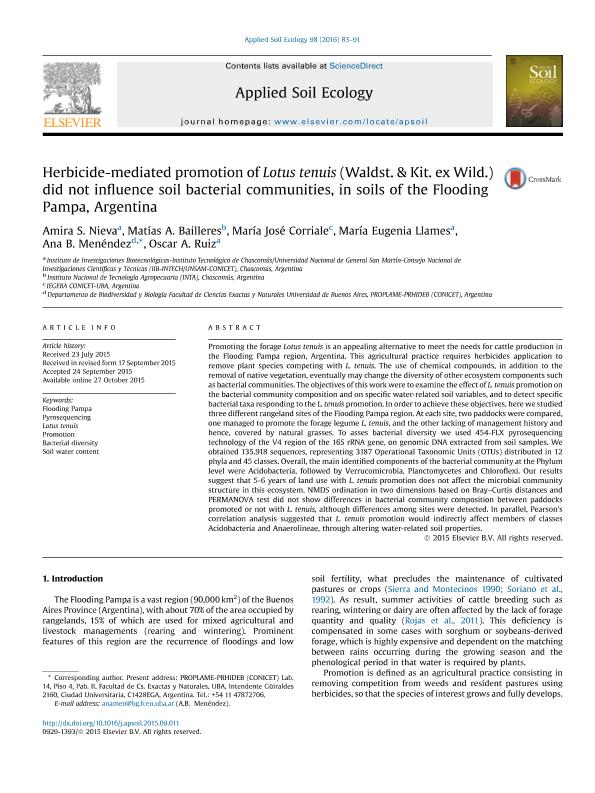Mostrar el registro sencillo del ítem
dc.contributor.author
Nieva, Amira Susana del Valle

dc.contributor.author
Bailleres, Matías Andres

dc.contributor.author
Corriale, Maria Jose

dc.contributor.author
Llames, Maria Eugenia del Rosario

dc.contributor.author
Menendez, Ana Bernardina

dc.contributor.author
Ruiz, Oscar Adolfo

dc.date.available
2018-05-23T15:25:03Z
dc.date.issued
2016-02
dc.identifier.citation
Nieva, Amira Susana del Valle; Bailleres, Matías Andres; Corriale, Maria Jose; Llames, Maria Eugenia del Rosario; Menendez, Ana Bernardina; et al.; Herbicide-mediated promotion of Lotus tenuis (Waldst. & Kit. ex Wild.) did not influence soil bacterial communities, in soils of the Flooding Pampa, Argentina; Elsevier Science; Applied Soil Ecology; 98; 2-2016; 83-91
dc.identifier.issn
0929-1393
dc.identifier.uri
http://hdl.handle.net/11336/45994
dc.description.abstract
Promoting the forage Lotus tenuis is an appealing alternative to meet the needs for cattle production in the Flooding Pampa region, Argentina. This agricultural practice requires herbicides application to remove plant species competing with L. tenuis. The use of chemical compounds, in addition to the removal of native vegetation, eventually may change the diversity of other ecosystem components such as bacterial communities. The objectives of this work were to examine the effect of L. tenuis promotion on the bacterial community composition and on specific water-related soil variables, and to detect specific bacterial taxa responding to the L. tenuis promotion. In order to achieve these objectives, here we studied three different rangeland sites of the Flooding Pampa region. At each site, two paddocks were compared, one managed to promote the forage legume L. tenuis, and the other lacking of management history and hence, covered by natural grasses. To asses bacterial diversity we used 454-FLX pyrosequencing technology of the V4 region of the 16S rRNA gene, on genomic DNA extracted from soil samples. We obtained 135.918 sequences, representing 3187 Operational Taxonomic Units (OTUs) distributed in 12 phyla and 45 classes. Overall, the main identified components of the bacterial community at the Phylum level were Acidobacteria, followed by Verrucomicrobia, Planctomycetes and Chloroflexi. Our results suggest that 5-6 years of land use with L. tenuis promotion does not affect the microbial community structure in this ecosystem. NMDS ordination in two dimensions based on Bray?Curtis distances and PERMANOVA test did not show differences in bacterial community composition between paddocks promoted or not with L. tenuis, although differences among sites were detected. In parallel, Pearson?s correlation analysis suggested that L. tenuis promotion would indirectly affect members of classes Acidobacteria and Anaerolineae, through altering water-related soil properties.
dc.format
application/pdf
dc.language.iso
eng
dc.publisher
Elsevier Science

dc.rights
info:eu-repo/semantics/openAccess
dc.rights.uri
https://creativecommons.org/licenses/by-nc-sa/2.5/ar/
dc.subject
Flooding Pampa
dc.subject
Pyrosequencing
dc.subject
Lotus Tenuis
dc.subject
Promotion
dc.subject
Bacterial Diversity
dc.subject
Soil Water Content
dc.subject.classification
Otras Ciencias Biológicas

dc.subject.classification
Ciencias Biológicas

dc.subject.classification
CIENCIAS NATURALES Y EXACTAS

dc.title
Herbicide-mediated promotion of Lotus tenuis (Waldst. & Kit. ex Wild.) did not influence soil bacterial communities, in soils of the Flooding Pampa, Argentina
dc.type
info:eu-repo/semantics/article
dc.type
info:ar-repo/semantics/artículo
dc.type
info:eu-repo/semantics/publishedVersion
dc.date.updated
2018-04-27T18:53:00Z
dc.journal.volume
98
dc.journal.pagination
83-91
dc.journal.pais
Países Bajos

dc.journal.ciudad
Amsterdam
dc.description.fil
Fil: Nieva, Amira Susana del Valle. Consejo Nacional de Investigaciones Científicas y Técnicas. Centro Científico Tecnológico Conicet - La Plata. Instituto de Investigaciones Biotecnológicas. Instituto de Investigaciones Biotecnológicas "Dr. Raúl Alfonsín" (sede Chascomús). Universidad Nacional de San Martín. Instituto de Investigaciones Biotecnológicas. Instituto de Investigaciones Biotecnológicas "Dr. Raúl Alfonsín" (sede Chascomús); Argentina
dc.description.fil
Fil: Bailleres, Matías Andres. Instituto Nacional de Tecnología Agropecuaria; Argentina
dc.description.fil
Fil: Corriale, Maria Jose. Consejo Nacional de Investigaciones Científicas y Técnicas. Oficina de Coordinación Administrativa Ciudad Universitaria. Instituto de Ecología, Genética y Evolución de Buenos Aires. Universidad de Buenos Aires. Facultad de Ciencias Exactas y Naturales. Instituto de Ecología, Genética y Evolución de Buenos Aires; Argentina
dc.description.fil
Fil: Llames, Maria Eugenia del Rosario. Consejo Nacional de Investigaciones Científicas y Técnicas. Centro Científico Tecnológico Conicet - La Plata. Instituto de Investigaciones Biotecnológicas. Instituto de Investigaciones Biotecnológicas "Dr. Raúl Alfonsín" (sede Chascomús). Universidad Nacional de San Martín. Instituto de Investigaciones Biotecnológicas. Instituto de Investigaciones Biotecnológicas "Dr. Raúl Alfonsín" (sede Chascomús); Argentina
dc.description.fil
Fil: Menendez, Ana Bernardina. Consejo Nacional de Investigaciones Científicas y Técnicas; Argentina. Universidad de Buenos Aires. Facultad de Ciencias Exactas y Naturales. Departamento de Biodiversidad y Biología Experimental; Argentina
dc.description.fil
Fil: Ruiz, Oscar Adolfo. Consejo Nacional de Investigaciones Científicas y Técnicas. Centro Científico Tecnológico Conicet - La Plata. Instituto de Investigaciones Biotecnológicas. Instituto de Investigaciones Biotecnológicas "Dr. Raúl Alfonsín" (sede Chascomús). Universidad Nacional de San Martín. Instituto de Investigaciones Biotecnológicas. Instituto de Investigaciones Biotecnológicas "Dr. Raúl Alfonsín" (sede Chascomús); Argentina
dc.journal.title
Applied Soil Ecology

dc.relation.alternativeid
info:eu-repo/semantics/altIdentifier/doi/https://dx.doi.org/10.1016/j.apsoil.2015.09.011
dc.relation.alternativeid
info:eu-repo/semantics/altIdentifier/url/https://www.sciencedirect.com/science/article/pii/S0929139315300901
Archivos asociados
